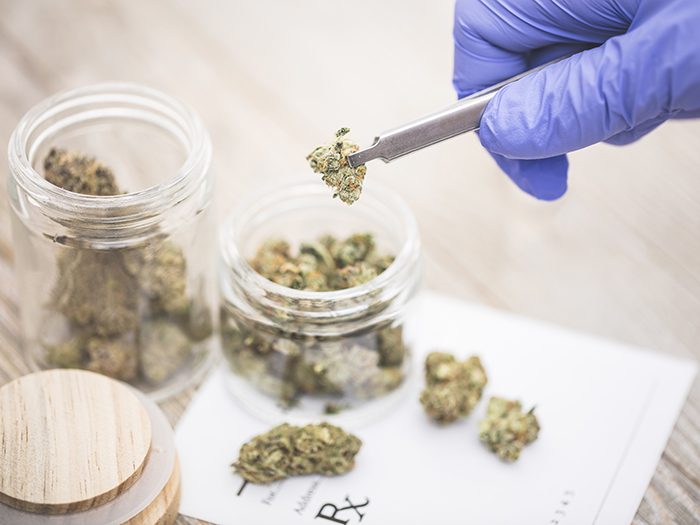Medical-Marijuana Acceptance Is Getting Close, But Obstacles Remain

Interest in treating chronic pain with marijuana as one potential alternative to opioid pain relievers is growing — both among the medical community and the public.
But physicians and insurers lack the research and dosing guidance to accommodate marijuana’s prescribing and claim payments. Fortunately that could change.
That’s the perspective of two experts from Healthesystems: chief medical officer Robert Goldberg, and Associate Vice President of Advocacy & Compliance Sandy Shtab. Healthesystems provides pharmacy benefit management services for workers’ compensation payers. The experts’ assessments come amid a growing number of studies showing that the use and prescribing of addictive and deadly opioid pain killers has decreased in states where marijuana is legal.
The trend goes back to 1996 when California adopted the “Compassionate Use Act” which allowed medical cannabis use, said Goldberg.
“For the last 22 years, California actually has had lower opioid use and overdose death rates compared to the other states,” as patients turn to marijuana to treat chronic pain, he said.
Recent research findings show a similar pattern in other states.
Existing evidence, meanwhile, shows opioids are ineffective in treating chronic pain. They can even increase pain systems and often contribute to additional patient disability.
Robert Goldberg and Sandy Shtab discuss the part cannabis could play in further driving down opioid usage rates.
Considering medical complications, costs and overdose deaths associated with opioid use, doctors are growing interested in marijuana’s potential as an option among alternatives, Goldberg said.
“We have been conditioned as a medical community for the last 50 or 60 years to think of marijuana as the devil weed, or ‘Reefer Madness’ kind of mentality,” Goldberg said. “But I think we are starting to see that the natural experiment that has occurred over the last 40 or 50 years is showing that opioids have produced incredible havoc in our country and our society.
“When you start to look at those kind of public health statistics, it can’t help but change the way physicians look at the relative risks and benefits of opioids versus marijuana,” he added.
But with marijuana remaining illegal under federal law, physicians who might otherwise prescribe cannabis risk losing their medical licenses. And a limited amount of pharmaceutical research on cannabis means doctors don’t have proper treatment or dose guidelines.
“When you start to look at those kind of public health statistics, it can’t help but change the way physicians look at the relative risks and benefits of opioids versus marijuana.” — Robert Goldberg, chief medical officer, Healthesystems
Insurers face a similar challenge. They won’t pay a claim absent dosing guidelines that could permit doctors to prescribe an appropriate and specific amount of cannabis treatment, said Shtab.
Just as doctors typically must prescribe a specific, limited number of physical therapy treatments before insurers pay a claim, the same would need to occur for medical marijuana, Shtab said. Insurers would never agree to pay for unlimited cannabis use, she elaborated.
Without treatment guidelines or established dosing amounts, the current state of medical marijuana use “boils down to a lot of trial and error, and carriers are not comfortable with a lot of trial and error,” Shtab said. “They are in the business of mitigating risks”
But that consideration must be balanced with the harms resulting from the current state of opioid prescribing, Goldberg said.
Claims payers are funding “long-term opioid therapy, and then overdoses and overdose deaths and emergency room visits and falls at home — based on opioid therapy that ties back to the original industrial injury and secondary medical effects [such as] respiratory depression, heart failure and so forth,” he explained.
Goldberg expects medical and scientific research on marijuana will emerge, eventually helping doctors determine appropriate dosing and which specific medical conditions may benefit from the drug.
Robert Goldberg and Sandy Shtab discuss how evolving cannabis policies may impact workers’ comp.
Once guidelines emerge, physicians, the public and payers will become more comfortable with a new form of treatment that could have lower risks and lower direct and indirect costs, he said.
But funding of scientific research and clinical trials will require federal authorities to remove marijuana from among a category of the most tightly restricted drugs, Shtab said. The Schedule 1 category includes drugs considered as having no accepted medical application.
“Once that happens, we are going to have a sea change across the country,” Shtab said.
State laws will need to change while dosing information, packaging and distribution channels will emerge as well as dosing guidelines.
“Carriers will know more based on those evidence-based guidelines what they should be paying for and what they should challenge,” Shtab said. “There has to be a very big education component to all of this.” &










